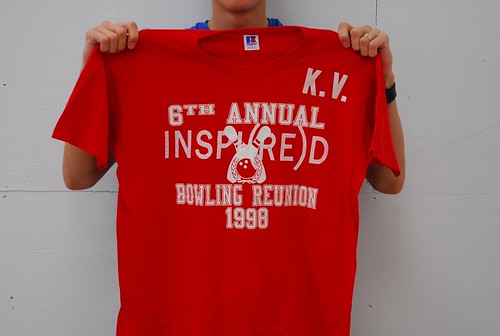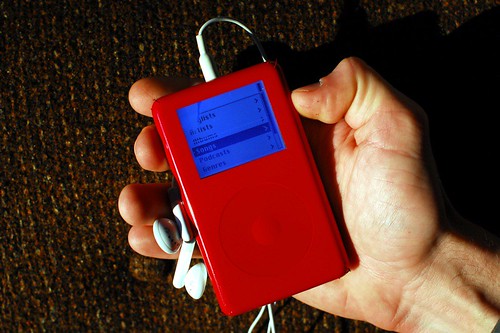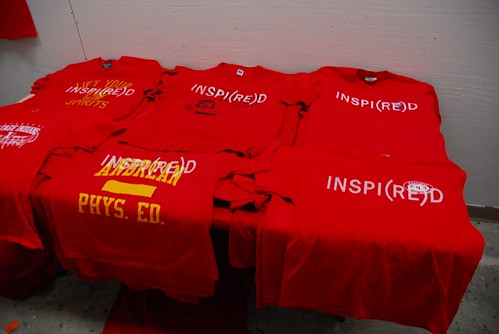Q&A: (RE)
Posted Under: Artists,Backlashing,Consumer Behavior,Q&A,Semiotic Disobedience,Things/Thinking
The widely discussed Product (Red) campaign has come up a couple of times here on Murketing. As you probably know, it involves various companies such as The Gap and Apple and American Express selling special red products: If you buy one, some portion of the proceeds go to fight AIDS in Africa. It’s fair to say that the response to this has been mixed.
One of the most interesting responses I’ve seen so far is an initiative called (RE). As its creators have explained, their view is that the (Red) campaign “implies that corporations, branding and consumption are a necessary and healthy part of involvement in a cause. ” The point of (RE) is to offer non-corporate alternatives for engagement in causes — and to provoke some deeper thinking about conspicuous consumption, engagement, and solving the world’s problems. (The while the name “(RE)” riffs off “(RED),” it’s also echoed by manifestations of the project that explicitly involve re-use.)
Through February 15, (RE) is part of an exhibition called Other Options, at (106) S. Division gallery in Grand Rapids, Michigan, a show originated by InCubate in Chicago. On February 15, the creators of (RE) will auction red items, any red item at all, donated by anyone who wants to donate. Proceeds will go to charity. This is an example of the sort of thing that falls under the (RE) project.
I had a few Qs, and (RE)’s creators, Ryan Thompson and Phil Orr graciously provided some As. Here goes:
I’m curious — having read your F.A.Q. — to what extent (RE) is a response not just to (Red) specifically, but to “cause marketing” in general. (It’s become quite popular, as you know, for products and brands to “give a portion of proceeds” or “raise awareness,” etc. — from the Livestrong bracelet to … well all kinds of things).
You’re exactly right. When the (PRODUCT) RED campaign started back in October of ’06 we saw the opportunity for a timely response to (PRODUCT) RED specifically, but as we continued to expand the project we became aware of its ability to speak to much larger issues — concerns within cause marketing as well as consumption, waste, labor, etc. These aren’t easy issues to engage as a business or a consumer. That shouldn’t mean that we give up on trying, but instead that we look carefully at what supporting a cause in a particular manner does for all parties involved.
There are three (RE) manifestations, or initiatives — were they all devised at once, or did the project start with one idea and evolve to include the others?
 (RE) evolved slowly, starting originally with about a dozen T-shirts. At the time, eBay had became the only marketplace consumers could find the original (PRODUCT) RED Gap shirts — often paying two to three times the retail price.
(RE) evolved slowly, starting originally with about a dozen T-shirts. At the time, eBay had became the only marketplace consumers could find the original (PRODUCT) RED Gap shirts — often paying two to three times the retail price.
While The Gap rushed to produce more shirts to keep up with demand, we began offering an alternative — red thrift store t-shirts with white INSPI(RE)D text printed across any existing decoration. EBay searches for the shirts returned results for both (RE) shirts and the original (RED) shirts. This was the beginning of the first initiative — INSPI(RE)D — which eventually moved from eBay to the JoinRe.com website. Shirts are still available there.
Then, as the 2006 holiday shopping season progressed, demand for red products increased and (RE) expanded. Consumer demand for (RED) Apple iPods and Motorola RAZR phones inspired COVE(RE)D — a second initiative that encouraged consumers to emblazon their existing music players and phones with red vinyl.
A third response asks viewers to donate to and bid on a growing collection of under-utilized red items auctioned as (RE)SALE.
I should point out that your site says 100% of proceeds from the Inspi(re)d T-shirts goes to AIDS relief organizations. And also that the (Re)Sale event coming up on February 15 in Grand Rapids is your second, you did one in October in Chicago as well.
So what kind of reaction have you gotten? Any highlights?
Cause marketing tends to talk about reaction in terms of numbers: i.e., how much money was raised, or how many consumers bought a particular product. Our initiatives don’t ask for one straightforward way to respond, because there is a danger in over-simplifying the very issue(s) that you’re trying to address. The most pleasing responses are when people engage us or each other in the issues. Sometimes it means they choose to cover their phone with red vinyl, buy a t-shirt, or donate an item for auction, and sometimes it means they walk away and do something they feel is more appropriate.
And of course you got a a cease-and-desist from Product (Red). Where does that presently stand?
The cease and desist was something we were half expecting from the beginning, and when it showed up last spring we were excited to have received it. The way the letter was worded, we’re still not sure if they understood the project as a critique, or if they just saw it as someone ripping off their expensive branding.
As a genre, cease and desist orders aren’t much more than a scare tactic or hollow threat. With this sort of project we are squarely protected under parody laws and have no reason to cease or desist.
I liked the Cove(re)d idea — basically, make your own products red, and then give some money to a good cause. But that doesn’t seem to have gotten much traction, at least judging by the Flickr sets. Why, do you figure?
 Of the three initiatives, COVE(RE)D takes the most work on the consumer end. While we supply the vinyl, everything else is left to the consumer. It’s up to them to decide what their cove(re)d product is going to look like and where (and if) they will donate money. It is for these reasons that it avoids falling into some of the same pitfalls of the original campaign. We’ve had better response with COVE(RE)D recently when exhibiting the shows in Chicago and Grand Rapids. We will be posting a bunch of new COVE(RE)D photos after the close of the second OTHER OPTIONS show in February.
Of the three initiatives, COVE(RE)D takes the most work on the consumer end. While we supply the vinyl, everything else is left to the consumer. It’s up to them to decide what their cove(re)d product is going to look like and where (and if) they will donate money. It is for these reasons that it avoids falling into some of the same pitfalls of the original campaign. We’ve had better response with COVE(RE)D recently when exhibiting the shows in Chicago and Grand Rapids. We will be posting a bunch of new COVE(RE)D photos after the close of the second OTHER OPTIONS show in February.
Finally: I also really like the idea of turning existing red shirts into (RE) shirts by silk-screening on them. I once toyed with the idea of launching a joke brand in a similar way, just making a stencil available so any garment could be converted to this new, essentially non-existent brand. If I do that some day, will you sue me?
No, but expect a cease and desist letter from our lawyers!
Murketing thanks the creators of (RE) for answering these questions, and further thanks Anne Elizabeth Moore for the initial pointer. Visit (RE) at www.joinre.com, and/or reinspired.blogspot.com, or even www.flickr.com/photos/re_inspired.




 "
"













 Kim Fellner's book
Kim Fellner's book  A
A